Artist Interview No.6 – YUSUKE BONSAI KID- Part. 2
4名連続インタビュー企画の第二弾、濵本祐介さんの後編です。
海外での活動の話や、彼が創作のインスピレーションであり愛してやまないタトゥーにまつわる話など色々な話を聞いてみました。それでは、どうぞ。
This is the second part of Yusuke Hamamoto’s interview.
We asked him about his activities overseas, his love for tattoos, which inspire him to create, and many other things. Let’s have a look.
−盆栽は海外でも人気がありそうですが、やはり海外からのオファーも多いのでしょうか?
コロナ前は多かったですね。木は植物なので輸入・輸出が厳しくて、そこを逆手にとったという話じゃないですけど、現地で作るしかないので海外に行けるわけですよ。
そう思って海外に行ったら100本くらい木を用意されていて…そこから缶詰みたいなこともありましたけど(笑)
-Bonsai seems to be very popular overseas, do you get many offers from overseas?
Before Covid-19 pandemic, there were many. Since wood is a plant, importing and exporting it is very difficult. I’m not saying that I took advantage of this, but I had no choice but to make it locally, so I could go overseas.
When I went overseas, they had about 100 trees ready for me… I was sometimes in a can from there
−どこの国が多いのでしょうか?
ずっと長くやっているのはドイツ、それとアメリカのLAですね。
台湾、中国もありましたけど、基本はドイツ、アメリカの一辺倒です。
-Which countries are the most common?
I’ve been doing this for a long time in Germany, and in the United States.
There have been times when I’ve worked in Taiwan and China, but basically, I’ve always worked in Germany and the United States.
−海外の植物と日本の植物の違いとかで苦労などあったりするのでは?
それは全くないですね。似たような木を扱うので。
ただ気をつけないといけないのは、例えばカリフォルニアでは日射しが強いとか気候の違いはあるので、環境を司り、それに合うような体裁にしていく必要があります。
TPOってやつですね(笑)
-Do you have any difficulties with the differences between foreign plants and Japanese plants?
That’s not true at all. We deal with similar trees.
The only thing you have to be careful of is the difference in climates, for example, in California, there is a lot of sunshine, so you have to control the environment and make the appearance to fit it.
It’s called TPO(Time, Place and Occasion) lol
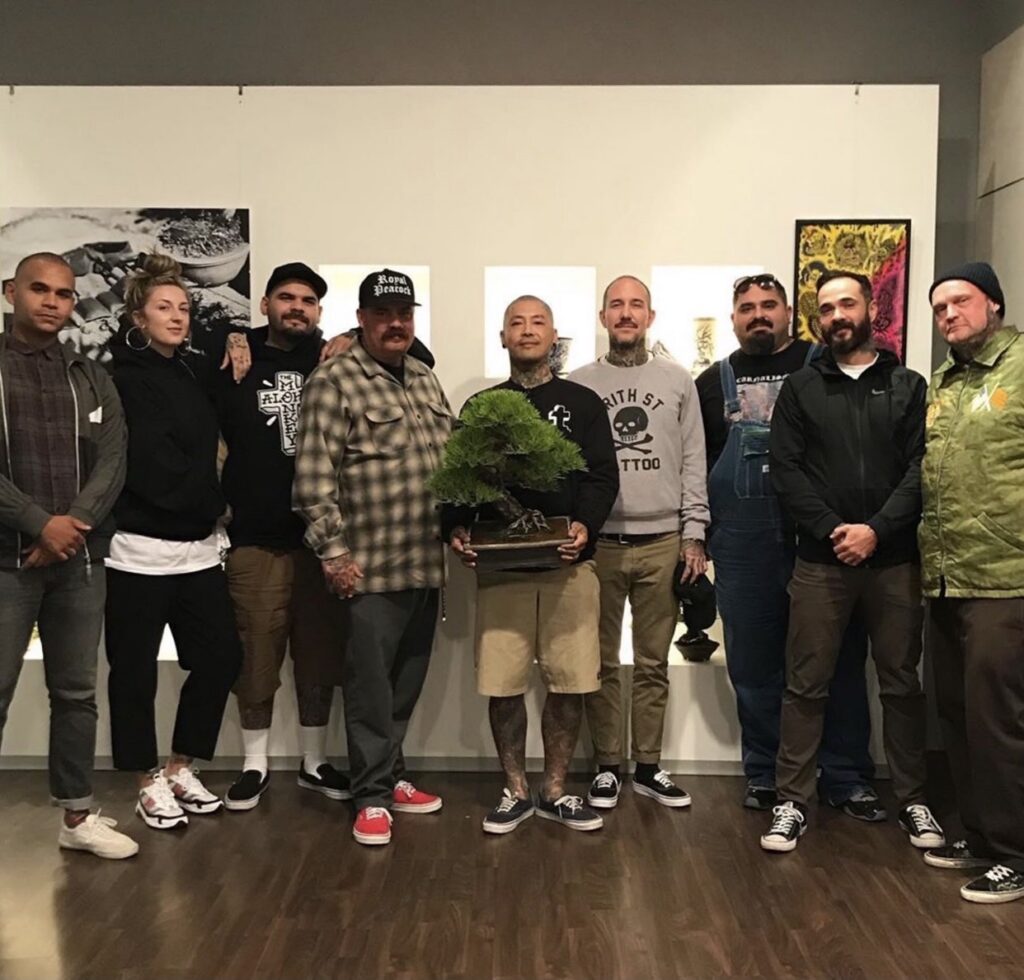
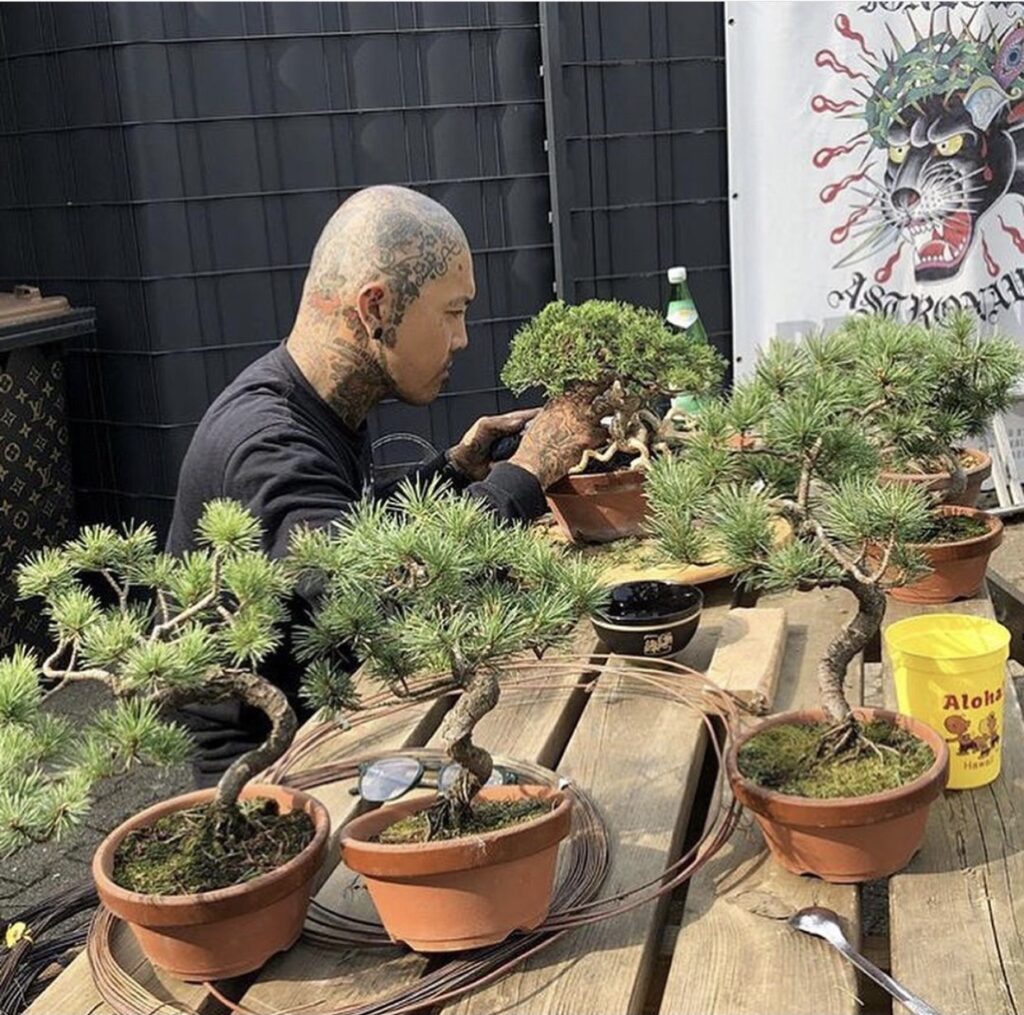
ロサンゼルスでの仕事の一場面。
A scene from his work in Los Angeles.
−海外の仕事は個人のお客さまからなのでしょうか?
僕はタトゥーが好きなのですが、日本人がアメリカン・タトゥーに憧れるようにアメリカ人って和彫りや盆栽に憧れがあって。
それで毎年海外に行っては、友達の彫師に自分の身体にタトゥーを入れてもらって代わりに盆栽を作ってトレードをする…みたいなことをしていて、それが横の繋がりでどんどん広がっていき仕事になったという形ですね。
-Does your overseas work come from private clients?
I like tattoos, and Americans have a fascination with Japanese carving and bonsai, just like Japanese people have a fascination with American tattoos.
So every year I would go abroad and ask my friend to tattoo me and make bonsai trees for me to trade, and that kind of thing spread through horizontal connections and became my job.
−好きなものに関する繋がりが広がっていくのは素敵ですね!
若干話が脱線してしまうのですが、タトゥーを入れたキッカケなどはあるのでしょうか?
18歳に入れまして、高校生の時から憧れていたのですが、入れて欲しいタトゥーアーティストがLAにいて、辞書を調べながら電話してみたら予約が取れたっぽいぞと。高校卒業した後に半信半疑で一人でLAに行ってみたら、本当に彫ってもらえて。
最初の体験がすごく良かったのが大きいです。
ジェントルマンで親切にやってもらえて良くしてもらって「最高だな」って。そこからハマりました。
それからも、好きだから調べているうちにLAの環境や雰囲気がさらに好きになって、何回もいくようになって、スタンプラリー感覚で行くたびに増えていくみたいな(笑)
日本、ドイツ、アメリカの複数、バリ、タイでも彫ってもらって、今までに150人くらいに彫ってもらっていますね。
-It’s nice to see connections related to something you love expanding!
This is a bit of a digression, but is there any particular reason why you got a tattoo?
I got a tattoo when I was 18 years old, and I had been longing for one since I was in high school. The tattoo artist I wanted to get tattooed was in LA, and I called him while looking up the dictionary, and he said it looked like I could get an appointment. After graduating from high school, I went to L.A. by myself, half expecting to get a tattoo, but I did.
My first experience was very good, and that was a big factor.
The gentleman was kind and treated me well, and I thought, “This is great. I was hooked from there.
Even after that, as I kept researching because I liked it so much, I fell even more in love with the environment and atmosphere of L.A., so I kept going back, and it was like a stamp rally.
I’ve had my work engraved in Japan, Germany, several places in the US, Bali, and Thailand, and I’ve had about 150 people engrave for me so far.
−150人!!すごいですね!!海外だとタトゥーは、日本よりは根付いているイメージがありますが、さすがに濵本さんのレベルだと「おおっ!!すげえ!!」みたいな感じになりませんか?
周りの環境のせいなのかな、僕よりビッシリの人もいるので割と普通ですよ。
自分よりも入っていてカッコいいなと思っている人たちを見てしまっている所為もあって、あまりそういうことはないですね。
-150 people! That’s amazing! In other countries, tattoos are more common than in Japan, but at Hamamoto’s level, it’s as if they are surprised like,”Wow! Wow!”
Maybe it’s the environment around me, but there are people who have more tattoos than me, so it’s pretty normal. I don’t get to do that very often, partly because I look at the people who are in it and think it’s cooler than I do.
−ちなみに国内では周りの反応はどうでしょうか?センシティブな問題で、かなり議論されている話題だと思いますが。
マナーやエチケットの問題かなと思いますね。
やっぱりタトゥーというだけで不快な思いをする方はいらっしゃると思うので、必然的に長袖だし、ニット帽も被っています。決して目立ちたいわけではないので…。認めてもらうには地道な活動しかなくて、いきなり子どもの運動会に行ったら「なんだ!」ってなると思いますよ。だから自分が盆栽を作っている人間で、「あそこのお父さんだよね」と、どれだけ認知してもらえるかが重要だと考えています。地道に子どもを幼稚園に送り迎えをして、そこで挨拶とかもして、しっかり自分が何者であるかを認知してもらえるように心がけています。
-By the way, how do you think people will react to this in Japan? It’s a sensitive issue, and I think it’s a topic that’s been discussed quite a bit.
I think it’s a matter of manners and etiquette.
I think there are people who are offended by tattoos, so I wear long sleeves and a knit cap. It’s not that I want to stand out…The only way to get recognition is to work steadily, and if you suddenly go to your child’s field day, they will say, “What?” So, I think it is important for people to recognize that I am a bonsai creator and that I am the father there. I take my children to and from kindergarten and greet them there to make sure they know who I am.
−すごく、しっかり考えて行動に移されているのですね。ちなみに、ご自身のInstagramでタトゥーを彷彿させる絵もアップされていますけど、ご自身で描かれているのですよね?
そうなっちゃいますよね(笑)
知り合いの彫り師とのコラボで、蛇を友達が描いて、蝶々と盆栽を僕が描いたものです。
-You’ve been thinking very hard and taking action. By the way, on your Instagram, you have uploaded pictures that remind me of tattoos, but you draw them yourself, right?
That’s what happens, right?
It’s a collaboration with a carver I know, my friend drew the snake, and I drew the butterfly and bonsai.
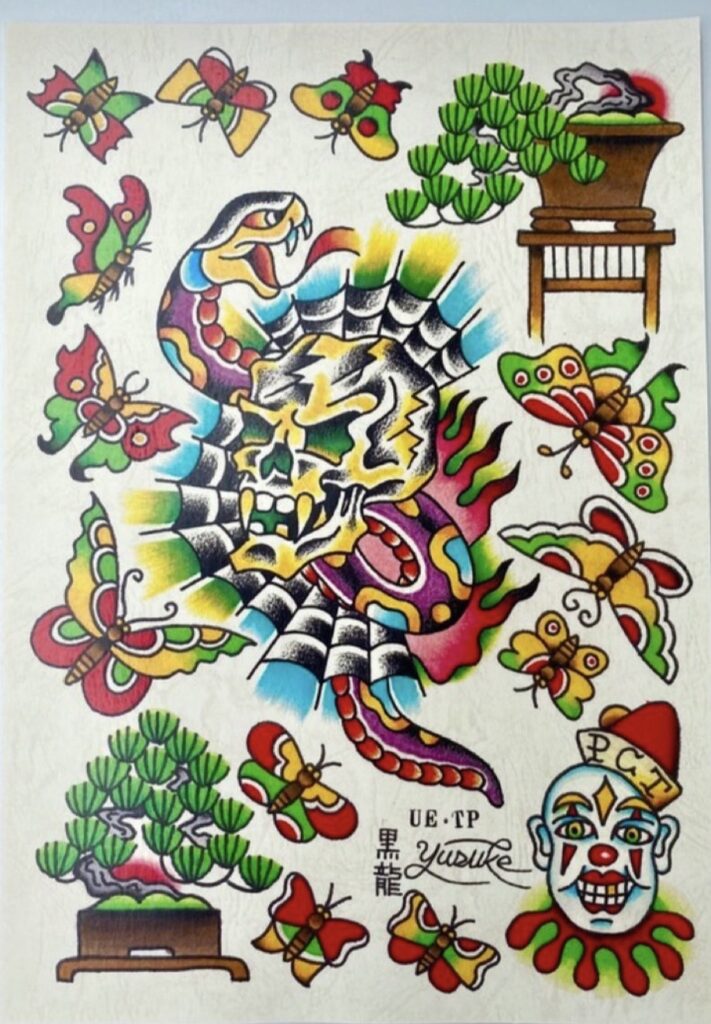
−なぜ絵を描くことに?
遊びですね。LAにいる時は彫師の人たちと一緒にいるんですけど、暇になるとペンを渡してきて「お前も描けよ!」みたいになるんですよね。それで最初はイタズラ描き程度で描いていたのですが、このペン使えよ!とかアドバイスもらっているうちに楽しくなってきちゃって。
描き出したら、ちょっと売れ出してきちゃって。満更でもねえなって(笑)
描いて3年目くらいなんですけど、ハマりやすい性分なんでしょうね。
盆栽も絵も。ずっとやっていられる。
子どもと一緒に描いたりもします。
-Why did you decide to paint?
It’s for fun.
When I’m in L.A., I hang out with the sculptors, and when they’re not busy, they hand me a pen and say, “You should draw, too!” At first, I was just drawing as a prank, but then they gave me advice like, “Use this pen! But as I got advice from them, I started to enjoy it.
Once I started drawing, I started to sell a little. I wasn’t complacent lol
I’ve been drawing for about three years now, but I guess I am easily addicted.
Bonsai and painting. I can do it all the time.
I also draw with my children.
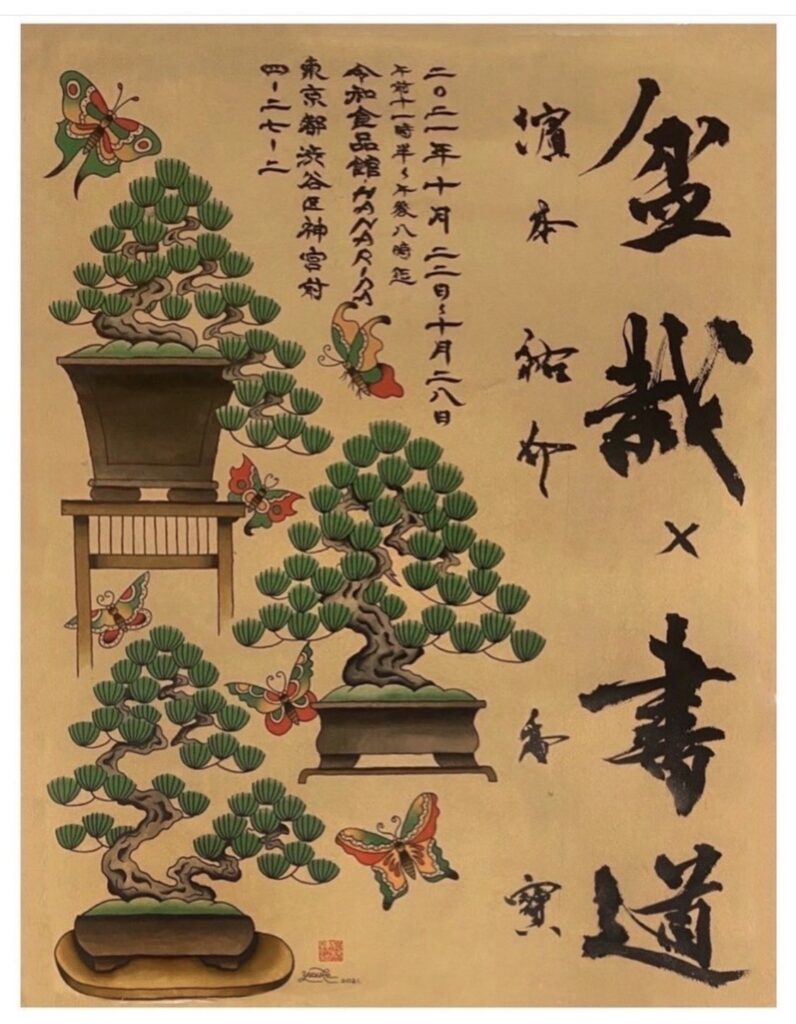
−絵のテイストや先ほどの話を聞いても、やっぱり彫師が技法のルーツになっているのですね。
そうですね。教えてくれたのが彫り師の人たちなので、タトゥーを入れるときの色の入れ方なんですよ。色をボカして逃げていく感じとかは完全にタトゥーの影響です。
-The taste of the painting and what you just said, the carver is still the root of the technique.
Yes, that’s right. The people who taught me were tattoo carvers, so it’s the way they put the colors in when they do the tattoos. The way they blur the colors and get away with it is completely influenced by the tattoos.
−緑が多いのも、タトゥーをルーツとしているからなのでしょうか?
ああ、そうですね。基本的には緑、黒、茶色、黄色、赤の5色で構成しています。昔のタトゥーは青がなくて5色で構成していたんですよ。あまりド派手に色を使うというよりは、そういう風にしたいですね。たまにワンチャン水色使うくらいですね(笑)
-Is it because of the greenery, or is it because of the tattoo roots?
Oh, yes. Basically, it consists of five colors: green, black, brown, yellow, and red. In the old days, tattoos didn’t have blue, so they were made up of five colors. I’d like to keep it that way rather than using too many flashy colors. Sometimes I even use a light blue.
−やっぱりタトゥーは創作活動に密接にリンクしていますね。
絵と盆栽の活動が双方に影響し合うことってありますか?
どっちも繋がっていますね。
植木屋さんが脚立にあがって木を切る時は、空がスケッチブックなんですよ。空に絵を描いている。
作品としての絵を描くときはキャンパスだけど。技術は積み重ねだし、あまり本質は変わらないですね。
でも絵のモチーフのマリア様とかはステンシルなどを見ないと描けないけど、盆栽だけは
自分の中のイメージをもとにフリーハンドで完璧に描けますね。
この木だったらこういう鉢だなぁとか。手が勝手に動いちゃう。すごいでしょ?(笑)
-After all, tattoos are closely linked to your creative work.
Do you find that your painting and bonsai activities influence each other?
They are both connected.
When a gardener gets up on a stepladder to cut a tree, the sky is a sketchbook. I’ m drawing a picture in the sky.
When I draw a picture as a work of art, it’s on the campus. Technique is an accumulation of skills, and the essence remains the same.
But I can’t draw the Virgin Mary or other motifs without looking at stencils, but I can draw bonsai perfectly freehand based on my own image.
I can draw a bonsai perfectly freehand based on my image. My hand just moves by itself. Isn’t that amazing? lol
−アーティストっぽいです(笑)
ちなみに盆栽アーティストって呼ばれ方をすることに違和感を感じたりするとかはありますか?
勿論、絵を描くと言う純粋にアーティスト的な一面も持っていますし、盆栽にもアートと捉えられる魅力は多数あるのは理解できたつもりなのですが、やっぱり濵本さんはそこまで「アートだ!」というよりは職人が産み出す命の伝統みたいに捉えているように考えている部分もあるのかなと勝手ながら感じました。
「アートってなんだろう?」とは考えますよね。
やっぱり以前は盆栽アーティストみたいな呼び方は、くすぐったい感じがしていて。
でもアメリカでの体験で変わりましたね。アメリカにいる時の人との会話とかを通して、自分がアーティストって言われたりするのが嫌いじゃなくなってきて、それがなんなのか分からないですけど。
でも、その呼び方も他人が決めることなのであまり拘ってはいなくて、全て作った盆栽次第だと思っています。
-I sound like an artist. lol
By the way, do you feel uncomfortable being called a bonsai artist?
Of course, I have a purely artistic side that draws pictures, and I understand that bonsai has many charms that can be considered art, but you don’t see it as art. I’m sure you can understand that bonsai has many charms that can be considered art, but I felt that you might be thinking of it more as a tradition of life produced by craftsmen than as art.
“What is art?” I think about it.
I used to feel tickled to be called a bonsai artist.
But my experience in America changed that. Through conversations with people in the US, I don’t mind being called an artist anymore.
I don’t know what it is, but I don’t really care what people call me, it all depends on the bonsai I make.
−なんとなく、作品という考え方に職人的なアティチュードを感じます。そのようなスタンスを持つからこそお聞きしたいのですが盆栽は敷居の高いものなのでしょうか?
そんなことはないと思いますよ。
敷居を下げるのも良くはないとは思いますし、伝統文化だとも思っているし、永く残って代々引き継がれるものだから軽く見ているつもりもありませんが、身近にある素材を使っていくらでも楽しめるものだと思っています。
-I feel a craftsman’s attitude in the idea that the end result is a work of art. Because of this stance, I would like to ask you, is bonsai a difficult thing to learn?
I don’t think that’s true.
I don’t think it’s good to lower the threshold, and I don’t mean to take it lightly because I also think it’s a traditional culture and something that will remain for a long time and be passed down from generation to generation, but I think it’s something that can be enjoyed as much as you want using materials that you have around you.
−なるほど。子供の頃の自分にとっての盆栽って、オジサンが楽しむ高尚なモノみたいなイメージがあって、さらに大人になると色々な世界や奥行きのありそうなものという情報が中途半端に入ってきて、なおさら手の出しづらいものなのかなぁと…。
論点がズレるかもしれないですが、命あるものだから、ペットを飼うのと同じくらいの気持ちじゃないとダメかもしれないですね。盆栽だって水をあげたりしなくてはいけないし、旅行に出る時は誰かに頼まなければいけない。買って終わりではなく、買ってから世話をしていくものなので。でも最近、犬を飼い始めて糞の世話とかをしていると、盆栽の方が楽だなって思いますけどね(笑)
-I see. When I was a child, I had an image of bonsai as a lofty thing for old men to enjoy, and when I became an adult, I received half-hearted information about the various worlds and depths of bonsai, so it was even more difficult for me to get involved.
This may be a moot point, but since it is a living thing, you may have to feel the same way about it as you do about a pet. Even a bonsai needs to be watered, and when you go on a trip, you have to ask someone to take care of it. It’s not the end of the world after you buy it, you have to take care of it after you buy it.
But recently, I got a dog and I have to take care of its feces, so I think bonsai is easier lol
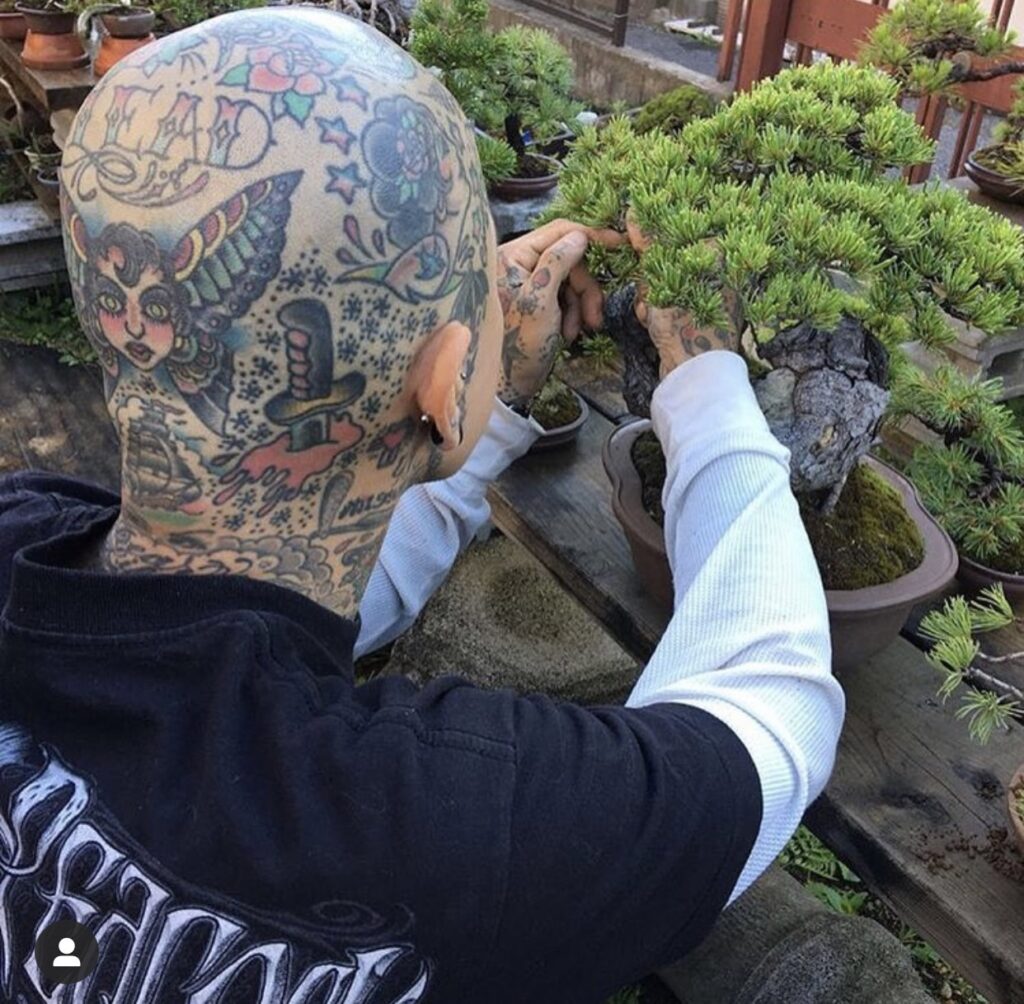
−犬も慣れれば、きっと大丈夫だと思いますよ!
最後のご質問になるのですが、今回の展示に対して考えていることってありますか?
愛情だけで終わらせてはいけない部分もありますが、自分が持っていきたいものを持っていくだけですね。テーマは決まっていますよね。「盆栽を描けばいいんだろ?」って話ですよね(笑)
まぁ、そこでしか勝負できないですしね(笑)
-I’m sure once the dogs get used to it, they’ll be fine!
As a final question, do you have any thoughts on this exhibit?
There is a part of me that doesn’t want to end up with just love, but I just want to bring what I want to bring.
You have a theme in mind, right? “Why don’t I just draw a bonsai tree?” lol Well, that’s the only way I can compete.
以上、濵本さんのインタビューでした。アート初心者の僕としては「盆栽もアートなのか!」という気づきと、改めて話を聞くことでアートとの共通項みたいなものも感じましたが、やはり盆栽は独自の世界観を持っていると思った次第です。
作品に命を吹きこみ、作品に生命力を芽吹かせ、魅力とさせることは良いアート作品の共通項だと思うのですが、濵本さんが盆栽について話す時は、盆栽を常に”命あるもの”としての前提で語っていて、”命”や”生と死を司る”というキーワードも出てきたりして、盆栽は生きている命と人のやり取りそのものだと感じました。
やっぱり、ここまで命が見えてくるからこそ盆栽は魅力を醸し出すのだろうし、そこに真摯に向き合った緊張感が空間を構成するからこそ、盆栽は美しいのだと今回のインタビューを通して学びました。
ぜひ皆さんも盆栽が醸し出す生命と、そこにインスピレーションを受けて描かれた絵を展示会で見て触れて欲しいと思います。
This is the interview with Mr. Hamamoto. As a beginner in art, I realized that bonsai is also art! As a beginner in the art world, I realized that bonsai is also art, and by listening to him again, I felt that bonsai has something in common with art, but I also thought that bonsai has its own world view.
I think that breathing life into a work of art, giving it life force and making it attractive is a common denominator of a good work of art, but when Mr. Hamamoto talks about bonsai, he always talks about bonsai as something that has life. When he talks about bonsai, he always talks about it as a “living thing” and the key words “life” and “life and death” come up, and I felt that bonsai is an interaction between living life and people.
Through this interview, I learned that bonsai is beautiful because it creates a sense of tension in the space.
I hope that everyone will visit the exhibition to see and touch the life that bonsai trees create and the pictures that are inspired by them.
さて次回の第三弾はナガモトマイさんです。猫、怪獣などのファンタジーを描きながらも、骨太にシビアな現実と向き合う彼女の魅力を発信していきます。お楽しみに。
The next installment of this series is by Mai Nagamoto. She draws cats, monsters, and other forms of fantasy, but also confronts serious reality in her work. Please look forward to it.
文:THAT IS GOOD 編集部:古賀
TEXT : THAT IS GOOD editorial department, Koga
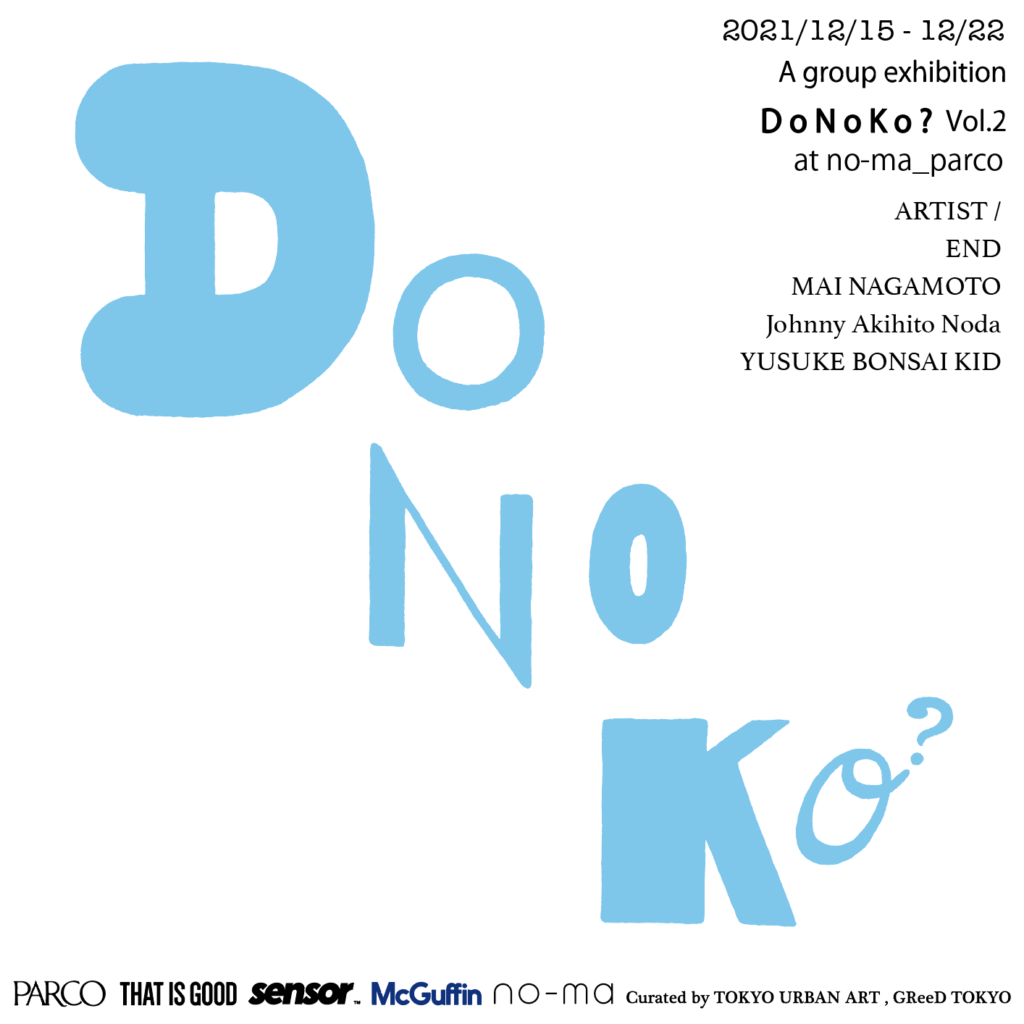
2021/12/15-12/22
A group exhibition
D o N o K o ? Vol.2
Curated by TOKYO URBAN ART , GReeD TOKYO
at @noma__official
ARTIST /
END
MAI NAGAMOTO
Johnny Akihito Noda
YUSUKE BONSAI KID
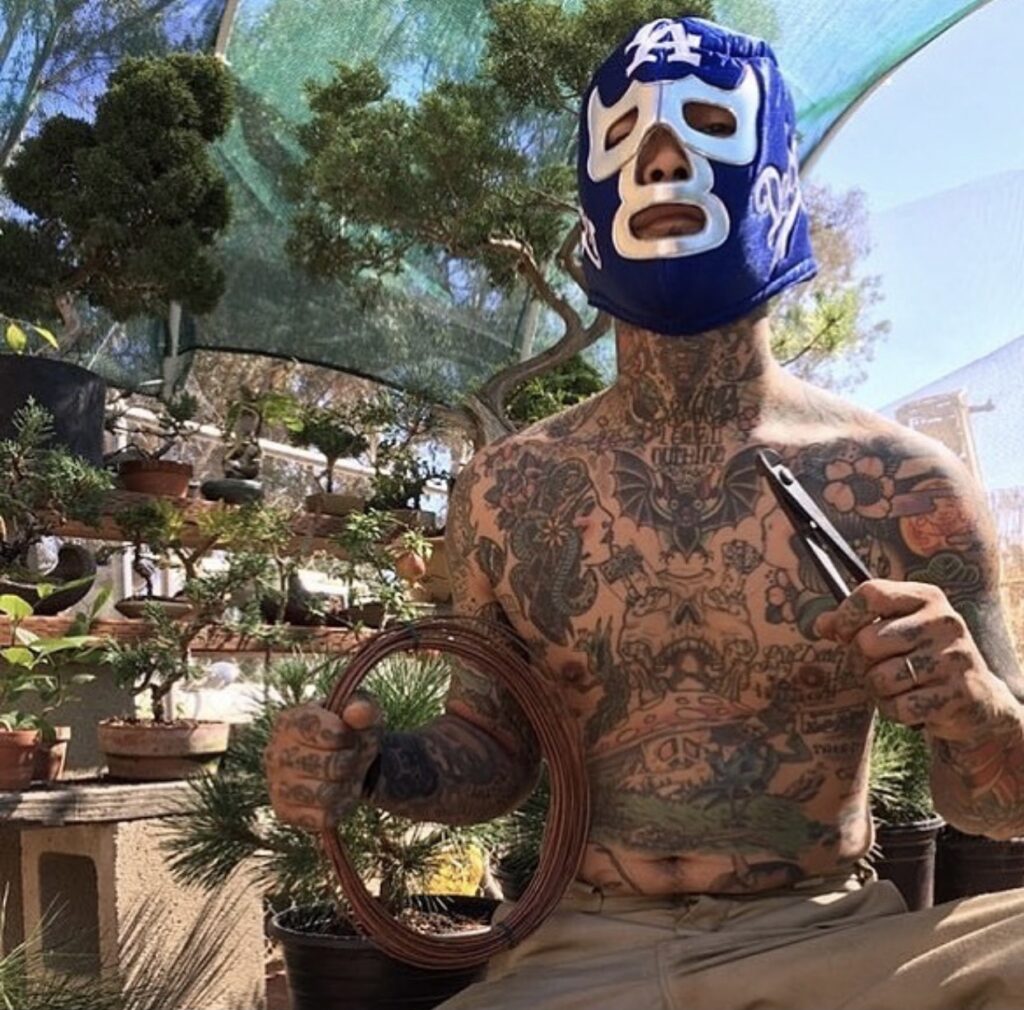
YUSUKE BONSAI KID / 濵本 祐介
1979年12月10日生まれ。
21歳の時、親方の元で修行を開始。29歳で独立、濵本峰松園を設立。二児のパパ。
Born on December 10, 1979.
He started training under his master at the age of 21, and became independent at the age of 29, establishing Hamamoto Minematsuen. He is the father of two children.
職歴
2015 MoMa design store Japan 展示販売
2016 Rooms 32 Best award 受賞
2016,17,18,19 年に2回 ロサンゼルスにて盆栽ワークショップ
2017 Acme Furniture コラボ 展示、販売
2018 TV東京 山田孝之がフォローする刺青だらけの盆栽職人出演
2018,19, 1年に2回ドイツにてワークショップ、タトゥーコンべンションにて盆栽展示、販売
2019 原宿にて単独の個展開催、
ロサンゼルスHurleyにて、プロサーファー、ロブマチャドとのコラボ、盆栽展示,物販販売
2019 ドイツにてアメリカから自分の友達のタトゥーアーティストを招き、アートショーを開催。(ドイツの盆栽雑誌、TVの取材、新聞にも取り上げられる)
2019 Hotel Koe Tokyo にてadidas スニーカー新作発表会に盆栽展示
2019 中国、ハワイ盆栽制作
2021, Amazonプライム キコキカク出演